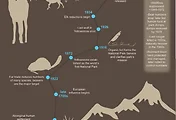주장 1.인간과 다른 영장류 수면 시간 (잠자는 시간) 비교. 인간 7시간, 다른 영장류 9~15시간.
주장 2. 이사벨라 카펠리니 (Isabella Capellini) 주장은, 인간과 비교한 30개의 영장류 숫자가 너무 적다. 적어도 300 종류의 영장류와 비교가 필요하다.
주장 1.
진화론적 인류학자들 (찰스 넌 Charles Nunn, 데이비드 샘슨 David Samson) 주장.
첫번째 이유, 인류가 옛날에 나무에서 땅으로 내려와서 살게 되었을 때, 포식자(약탈자)로부터 인류를 보호하기 위해 잠을 자지 않고 깨어 있는 시간이 더 많게 되었다.
두번째 이유는 새로운 기술을 배우고 가르치면서 사회적 관계를 형성하느라 잠을 줄이게 되었다.
수면 시간이 감소할 때, 학습과 기억과 연관된 수면을 뜻하는 ' 급속 안구 운동'이 수면에서 더 큰 역할을 하게 된다.
비-REM 수면은 기억을 도와주는 역할을 하지만, 예상과 달리 인간 수면에서 적은 부분을 차지한다.
REM (rapid-eye movement 급속 눈 운동) - 학습과 기억과 연관된 수면.
급속 안구 운동.
REM 수면.
NEWS
ANTHROPOLOGY
Humans don’t get enough sleep. Just ask other primates.
People devote more time to learning, at the expense of shut-eye, researchers propose
ring-tailed lemurs
SNOOZE TIME Humans get much less sleep than expected for a primate with our biological and lifestyle characteristics, a study finds.
Most other studied primates, including ring-tailed lemurs like these, sleep about as much on average as researchers estimated they should.
ARROWSG/ISTOCKPHOTO

By Bruce Bower
MARCH 7, 2018 AT 8:00 AM
People have evolved to sleep much less than chimps, baboons or any other primate studied so far.
A large comparison of primate sleep patterns finds that most species get somewhere between nine and 15 hours of shut-eye daily, while humans average just seven.
An analysis of several lifestyle and biological factors, however, predicts people should get 9.55 hours, researchers report online February 14 in the American Journal of Physical Anthropology. Most other primates in the study typically sleep as much as the scientists’ statistical models predict they should.
The best of Science News - direct to your inbox.
Headlines and summaries of the latest Science News articles, delivered to your email inbox every Thursday.
Two long-standing features of human life have contributed to unusually short sleep times, argue evolutionary anthropologists Charles Nunn of Duke University and David Samson of the University of Toronto Mississauga.
First, when humans’ ancestors descended from the trees to sleep on the ground, individuals probably had to spend more time awake to guard against predator attacks.
진화론적 인류학자들 (찰스 넌 Charles Nunn, 데이비드 샘슨 David Samson) 주장.
첫번째 이유, 인류가 옛날에 나무에서 땅으로 내려와서 살게 되었을 때, 포식자(약탈자)로부터 인류를 보호하기 위해 잠을 자지 않고 깨어 있는 시간이 더 많게 되었다.
두번째 이유는 새로운 기술을 배우고 가르치면서 사회적 관계를 형성하느라 잠을 줄이게 되었다.
수면 시간이 감소할 때, 학습과 기억과 연관된 수면을 뜻하는 ' 급속 안구 운동'이 수면에서 더 큰 역할을 하게 된다.
비-REM 수면은 기억을 도와주는 역할을 하지만, 예상과 달리 인간 수면에서 적은 부분을 차지한다.
REM (rapid-eye movement 급속 눈 운동) - 학습과 기억과 연관된 수면.
급속 안구 운동.
REM 수면.
Second, humans have faced intense pressure to learn and teach new skills and to make social connections at the expense of sleep.
As sleep declined, rapid-eye movement, or REM — sleep linked to learning and memory (SN: 6/11/16, p. 15) — came to play an outsize role in human slumber, the researchers propose. Non-REM sleep accounts for an unexpectedly small share of human sleep, although it may also aid memory (SN: 7/12/14, p. 8), the scientists contend.
“It’s pretty surprising that non-REM sleep time is so low in humans, but something had to give as we slept less,” Nunn says.
이사벨라 카펠리니 (Isabella Capellini) 주장은, 인간과 비교한 30개의 영장류 숫자가 너무 적다. 적어도 300 종류의 영장류와 비교가 필요하다.
Humans may sleep for a surprisingly short time, but Nunn and Samson’s sample of 30 species is too small to reach any firm conclusions, says evolutionary biologist Isabella Capellini of the University of Hull in England. Estimated numbers of primate species often reach 300 or more.
Sleeper effect
In this chart showing a subset of the data on how long primates sleep, humans stand out as snoozing the fewest hours daily, on average. They were also among three primates (dark blue bars) whose sleep times differed substantially from researchers’ predictions.
E. OTWELL
Source: C.L. Nunn and D.R. Samson/American Journal of Physical Anthropology 2018
If the findings hold up, Capellini suspects that sleeping for the most part in one major bout per day, rather than in several episodes of varying durations as some primates do, substantially lessened human sleep time.
Nunn and Samson used two statistical models to calculate expected daily amounts of sleep for each species. For 20 of those species, enough data existed to estimate expected amounts of REM and non-REM sleep.
Estimates of all sleep times relied on databases of previous primate sleep findings, largely involving captive animals wearing electrodes that measure brain activity during slumber.
To generate predicted sleep values for each primate, the researchers consulted earlier studies of links between sleep patterns and various aspects of primate biology, behavior and environments.
야행성 동물이 낮에 활동하는 동물보다 더 많이 잔다.
For instance, nocturnal animals tend to sleep more than those awake during the day.
Species traveling in small groups or inhabiting open habitats along with predators tend to sleep less.
Based on such factors, the researchers predicted humans should sleep an average of 9.55 hours each day. People today sleep an average of seven hours daily, and even less in some small-scale groups (SN: 2/18/17, p. 13).
The 36 percent shortfall between predicted and actual sleep is far greater than for any other primate in the study.
Nunn and Samson estimated that people now spend an average of 1.56 hours of snooze time in REM, about as much as the models predict should be spent in that sleep phase.
An apparent rise in the proportion of human sleep devoted to REM resulted mainly from a hefty decline in non-REM sleep, the scientists say. By their calculations, people should spend an average of 8.42 hours in non-REM sleep daily, whereas the actual figure reaches only 5.41 hours.
One other primate, South America’s common marmoset (Callithrix jacchus), sleeps less than predicted. Common marmosets sleep an average of 9.5 hours and also exhibit less non-REM sleep than expected. One species sleeps more than predicted:
South America’s nocturnal three-striped night monkey (Aotus trivirgatus) catches nearly 17 hours of shut-eye every day. Why these species’ sleep patterns don’t match up with expectations is unclear, Nunn says. Neither monkey departs from predicted sleep patterns to the extent that humans do.
Questions or comments on this article? E-mail us at feedback@sciencenews.org | Reprints FAQ
A version of this article appears in the March 31, 2018 issue of Science News.
CITATIONS
C.L. Nunn and D.R. Samson. Sleep in a comparative context: Investigating how human sleep differs from sleep in other primates. American Journal of Physical Anthropology. Published online February 14, 2018. doi:10.1002/ajpa.23427.
https://www.sciencenews.org/article/humans-primates-sleep-evolution
Why humans get less sleep than other primates
24 May 2022


